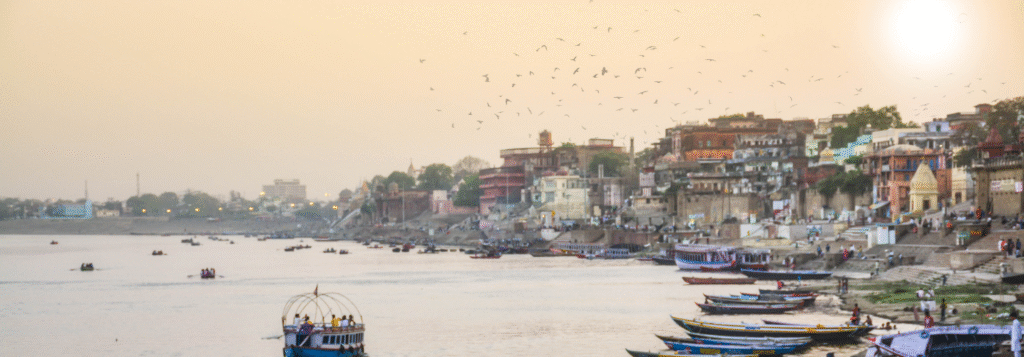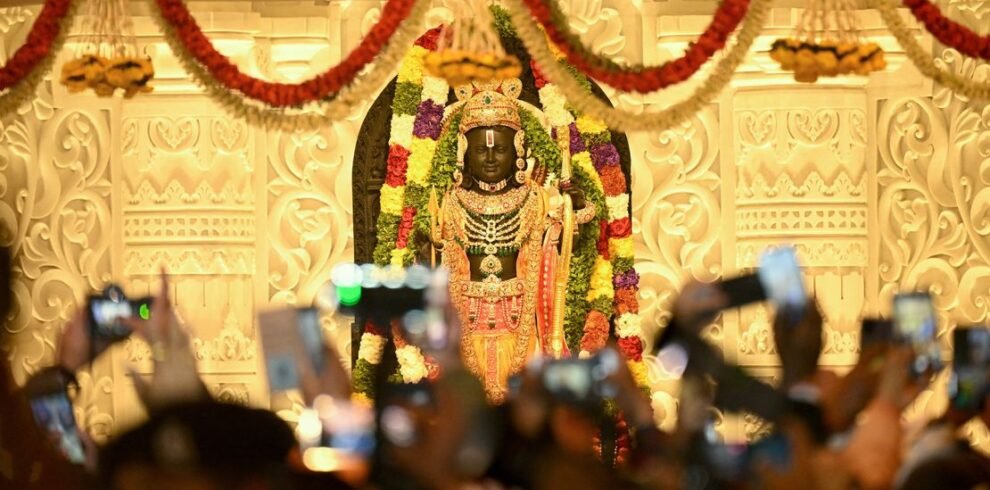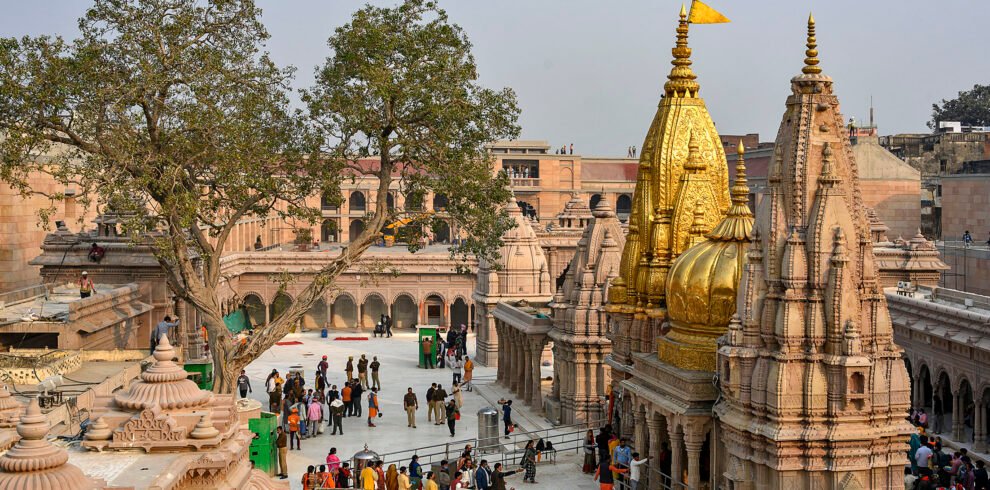Explore Kashi History, Spiritual Significance, Architectural Heritage & Festivals
Kashi History, known in contemporary times as Varanasi, stands as a testament to the intersection of spirituality and history. Recognized as one of the world’s oldest inhabited cities, it boasts a lineage that extends back over 3,000 years, making it an essential study for both historians and pilgrims. The term “Kashi,” derived from the Sanskrit word “Kash,” signifies brightness or illumination, suggesting a long-held association with knowledge and enlightenment.

The city’s roots trace their origins to the ancient Vedic period, during which it became a significant center for trade and culture. Its strategic geographical location along the banks of the Ganges River facilitated commercial exchanges and attracted numerous settlers, contributing to its fame as a vibrant urban hub. Kashi’s prominence in tales of mythology further enhances its historical gravity, with numerous texts glorifying its existence as a city of divine significance. The Ganges, regarded as a sacred river, plays a pivotal role in Kashi’s spiritual narrative, enhancing its allure as both a pilgrim destination and a historical marvel.
Throughout the centuries, Kashi has witnessed the ebb and flow of various empires and cultures, each leaving an indelible mark on the city. This city showcases a rich tapestry of architectural styles, from the ancient temples and ghats that line the riverbank to the more contemporary structures that have emerged over time. Such historical yet evolving nature continues to attract scholars, researchers, and pilgrims alike, who are drawn by the city’s promise of historical discovery intertwined with spiritual fulfillment. Kashi’s heritage thus serves as a treasure trove, inviting an exploration of its layered past while providing insights into the cultural and religious currents that shaped its identity.
Cultural Significance of Kashi
Kashi, also known as Varanasi, possesses a rich cultural significance that extends beyond its religious importance. The city is a melting pot of diverse traditions, customs, and beliefs, making it a prime destination for both pilgrims and history enthusiasts. The intertwining of various religions—most notably Hinduism, Buddhism, and Jainism—enhances Kashi’s status as a historical and spiritual hub.
The presence of numerous ghats along the Ganges River serves as a testament to Kashi’s vibrant heritage. Each ghat is steeped in historical narratives and religious practices, where rituals are performed daily. The Dashashwamedh Ghat, for instance, is famous for the Ganga Aarti, a ceremony that attracts thousands of devotees and tourists alike, highlighting the communal spirit that characterizes Kashi. This sacred city has been a pivotal point for pilgrims seeking spiritual solace and enlightenment, who believe that a visit to Kashi can lead to moksha or liberation.
Kashi’s cultural significance is also reflected in its festivals, which showcase a blend of local traditions. Celebrations like Dev Deepawali and Mahashivratri witness an influx of visitors, drawn by the vibrant atmosphere and the opportunity to participate in the rich cultural practices. The festivities symbolize the deep reverence the locals hold for their heritage.
The city is also adorned with historical structures, such as the Kashi Vishwanath Temple, which is an architectural marvel and a prime example of religious devotion. Such sites not only hold spiritual importance but also serve as a reminder of Kashi’s historical significance as a centre of learning and culture throughout the centuries. For history buffs, this provides a fascinating insight into the evolution of religious practices and societal structures in the region.
As Kashi continues to evolve, it remains deeply rooted in its diverse cultural heritage, making it an essential destination for those eager to explore the intricate layers of history and spirituality that it offers.
Architectural Marvels: Temples and Ghats
Kashi, also known as Varanasi, is renowned for its rich architectural heritage, particularly its temples and ghats, which are not only central to its spiritual identity but also serve as remarkable examples of ancient Indian craftsmanship. The city is dotted with numerous temples, with the Kashi Vishwanath Temple being one of the most significant and revered. This temple, dedicated to Lord Shiva, attracts millions of pilgrims each year who seek blessings at this sacred site. Its intricate carvings and spiritual ambiance exemplify the architectural prowess of the time, symbolizing the blend of devotion and artistry.

Beyond temples, the ghats of Kashi hold a distinctive place in the hearts of both residents and visitors. The Dashashwamedh Ghat, one of the most popular ghats, is not only a picturesque spot along the banks of the Ganges but also a vital center for rituals and ceremonies. The mesmerizing Ganga Aarti performed here every evening draws crowds, enhancing the ghat’s allure. Each ghat has its own unique history and significance, contributing layers to the cultural tapestry of the city. This blend of spirituality and history makes Kashi a vibrant hub for explorers interested in the architectural magnificence of sacred spaces.
The construction styles of the temples and ghats reflect various periods of Indian history, showcasing influences from different dynasties and cultural movements. The region’s architecture exhibits classical and contemporary elements, revealing its adaptability and evolution over centuries. This diversity is a testament to Kashi’s longstanding heritage, which continues to be cherished by those who visit for spiritual or historical exploration.
In conclusion, Kashi’s temples and ghats not only offer a glimpse into the architectural brilliance of the era but also act as focal points of spiritual and cultural life, making them essential sites for history enthusiasts and pilgrims alike.
Kashi’s Role in Indian Spirituality
Kashi, also known as Varanasi, holds a significant position in Indian spirituality, revered by millions for its sacred connotations and rich cultural heritage. Situated on the banks of the Ganges River, Kashi is not only one of the oldest inhabited cities in the world but also a vital pilgrimage destination for Hindus. This ancient city represents the epitome of spiritual awakening and enlightenment, drawing devotees from far and wide who seek solace and divine connection.
The Ganges River, considered the holiest river in Hinduism, plays an integral role in the spiritual practices observed in Kashi. Many pilgrims undertake ritualistic baths in its sacred waters to cleanse their souls and attain spiritual purity. The act of immersing oneself in the Ganges is believed to absolve sins and pave the way for liberation (moksha). Furthermore, the river serves as a backdrop for numerous religious rites and ceremonies, including the daily Ganga Aarti, a mesmerizing ritual involving the offering of lights to the river, celebrating the divine essence of the Ganges.
Rituals and customs prevalent in Kashi reflect the deep-seated cultural and spiritual ethos of the city. The various ghats (steps leading to the river) are key sites for many important rites of passage, including cremation ceremonies, where it is believed that departing from this world in Kashi ensures immediate entry into heaven. Such practices give Kashi its moniker, the City of Light, symbolizing the pursuit of ultimate truth and knowledge.
As a spiritual center, Kashi attracts seekers, sages, and scholars to engage with its hallowed history and sacred practices. For those on a quest for enlightenment, Kashi embodies a unique convergence of profound spirituality and unbroken traditions, making it a treasure trove for history buffs and pilgrims alike. The city’s spiritual legacy endures, continuously weaving together the threads of devotion and cultural significance in the rich tapestry of Indian heritage.
Festivals and Celebrations: A Vibrant Heritage
Explore Kashi history, spiritual significance of Varanasi, architectural heritage, and vibrant Kashi festivals with Seven Sands Tourism from Bangalore.

Embark on a soulful journey with our Kashi Ayodhya Tour Package 3 Nights 4 Days from Bangalore, specially crafted for…

Experience divine bliss with our Kashi Ayodhya Tour Package from Bangalore 4N/5D, designed by Seven Sands Tourism for devotees seeking…
Kashi, also known as Varanasi, is not only a city steeped in history but is also a vibrant hub for festivals and celebrations that attract both pilgrims and history enthusiasts. The multitude of festivals celebrated here is reflective of the rich cultural heritage that encompasses centuries of tradition, spirituality, and community bonding. Each festival tells a distinct story, showcasing the unique customs and rituals that have been passed down through generations.
One of the most significant festivals celebrated in Kashi is Dev Deepawali, which occurs on the full moon day of Kartik month. During this festival, the ghats are illuminated with countless diyas, creating a mesmerizing spectacle. This event not only holds religious significance but also serves as an opportunity for locals and visitors to come together, reinforcing communal ties while celebrating their shared heritage.
Additionally, Kashi hosts the Ganga Mahotsav, a festival that celebrates the sacred river, Ganga. This five-day festival includes cultural performances, boat races, and rituals that pay homage to the river as a lifeline of the city. The Ganga Mahotsav integrates history with contemporary festivities, attracting thousands who wish to learn about the lore surrounding the river while experiencing the magical atmosphere it creates.
Moreover, Makar Sankranti, celebrated in January, marks the transition of the sun into Capricorn and signifies the end of winter. It is characterized by colorful kite-flying contests and various local foods that deepen the historical roots of agrarian practices in the region. This integration of agriculture with spirituality highlights the interwoven nature of life in Kashi, illustrating how local customs evolve and adapt over time.
These celebrations not only enhance the cultural tapestry of Kashi but also emphasize its status as a destination for those interested in exploring the historical and spiritual dimensions of Indian heritage. By participating in these vibrant festivals, visitors find themselves immersed in the local customs, traditions, and narratives that are intrinsic to Kashi’s rich past.
Famous Personalities and Their Contributions
Kashi, known for its rich tapestry of cultural and spiritual heritage, has been home to numerous renowned personalities throughout history. These individuals have not only shaped the identity of the city but have also contributed significantly to Indian philosophy, literature, and politics. Their legacies continue to resonate, making Kashi a focal point for history enthusiasts and pilgrims alike.
One of the most distinguished figures associated with Kashi is the philosopher and spiritual leader, Adi Shankaracharya. Living in the 8th century, he is credited with consolidating the doctrine of Advaita Vedanta, advocating non-dualism and emphasizing the unity of the individual soul with the Supreme Consciousness. His contributions laid the groundwork for philosophical discourse in India, and his establishment of multiple monasteries in Kashi solidified the city as an intellectual hub.
In the realm of literature, the great poet Tulsidas, who composed the epic poem ‘Ramcharitmanas’ in the 16th century, made Kashi his home. His works not only revived Hindu devotion but also enriched the literary landscape of India. Tulsidas’s narratives of Lord Rama have inspired countless generations and continue to be revered in religious and cultural contexts.
Furthermore, Kashi has also been a significant site for political leaders striving for independence. One such figure is Pandit Madan Mohan Malaviya, the founder of Banaras Hindu University, who played a crucial role in the Indian independence movement. His educational initiatives have left a lasting impact, fostering generations of students who have gone on to contribute to various fields.
These personalities, among many others, have deeply entrenched their legacies within the fabric of Kashi. Their contributions continue to enhance the historical narrative of the city, making it a treasure trove for those interested in exploring the profound stories of its past.
Kashi’s Influence on Art and Literature
Kashi, known as Varanasi, has long been a vital source of inspiration for artists and writers from various epochs. Its rich tapestry of cultural and historical significance is reflected in numerous art forms, including painting, sculpture, and performance. Local artists have continually drawn upon the ancient city’s vibrant scenes—its ghats, temples, and the perennial flow of the Ganges to create works that encapsulate its spiritual essence. Traditional art forms like Madhubani and Bengal painting have often included themes from Kashi, showcasing the city’s unique blend of devotion and aesthetics.
Moreover, Kashi has been a subject of fascination for writers and poets, finding representation in both ancient scriptures and contemporary literature. Renowned literary figures, such as Tulsidas and Premchand, have penned works that incorporate Kashi’s soulful spirit and its influence on human experiences. The city’s atmosphere permeates modern-day literature as well, with authors often using Kashi as a backdrop for stories that explore themes of spirituality, mortality, and the quest for meaning. This interplay between place and narrative allows readers to immerse themselves in the duality of Kashi’s physical and ethereal landscapes.
The sacred city continues to inspire myriad forms of artistic expression today, from contemporary installations to digital art. Art festivals and exhibitions frequently highlight the works of local and international artists who explore Kashi’s multifaceted character. Additionally, literature festivals often celebrate the narratives that stem from the city, engaging audiences with discussions around its historical importance and ongoing influence on art and culture. By examining Kashi’s profound impact on art and literature, one can appreciate how this ancient city serves as a vibrant repository of human creativity, embodying the timeless connection between history, spirituality, and artistic expression.
Modern-Day Kashi: A Blend of Tradition and Change
Kashi, a city steeped in rich cultural history, has undergone significant transformation in recent years, juxtaposing its ancient heritage with modern urban dynamics. The intricate balance of tradition and modernization is a remarkable phenomenon that attracts various contemporary visitors, particularly history buffs and spiritual tourists seeking an immersive experience. While Kashi retains numerous historical landmarks, festivals, and rituals, it has embraced urbanization, aiming to enhance the quality of life for its residents and visitors alike.
The city’s infrastructure has evolved to support the influx of tourists, incorporating modern amenities while ensuring that the traditional essence remains intact. The historic ghats lining the Ganges River, for example, continue to draw visitors, not only for their spiritual significance but also for the scenic beauty that has been preserved amidst urban development. Additionally, the local cuisine, famous for its traditional delicacies, has adapted to modern tastes while also remaining deeply rooted in its cultural origins.
Kashi’s temples and cultural sites remain focal points of attraction, where architectural beauty reflects the craftsmanship of historical artisans. The Varanasi Gharana style of classical music continues to thrive, enriching the cultural tapestry of the city. This blend of tradition and change can be observed in various cultural festivals, which have seen an increase in participation due to the involvement of a younger generation eager to connect with their heritage while enjoying contemporary flair.
Modern transportation options have further facilitated easy access to Kashi, with budding infrastructures like hotels and guided tours enhancing the experience for pilgrims and history enthusiasts. The welcoming nature of the city ensures that visitors can explore its authenticity without losing the sense of connection to its deep-rooted past. Kashi’s evolution thus presents a fascinating case study on how a city can be a living testament to both heritage and modernity.
Practical Tips for Exploring Kashi’s Heritage
When embarking on a journey to Kashi, also known as Varanasi, there are several practical tips to enhance your exploration of its rich heritage. First, consider the timing of your visit. The best months to explore Kashi are from October to March, when the weather is cooler and more pleasant, allowing for comfortable outings to its numerous historical sites. Festivals during this period, such as Diwali and Makar Sankranti, also provide a unique glimpse into the vibrant local culture.
As you navigate the city’s intricate lanes, begin your exploration at the iconic Kashi Vishwanath Temple. Remember to dress modestly to respect the sanctity of this revered pilgrimage site. Subsequently, make your way to the Ghats along the Ganges River; each Ghat has its unique significance and historical background. The Dashashwamedh Ghat, in particular, is known for its majestic Ganga Aarti, providing a breathtaking spiritual experience that encapsulates the essence of Kashi.
For a deeper understanding of Kashi’s past, visiting the various museums, such as the Kashi Vanika Museum, can be incredibly enlightening. Local guides can offer valuable insights into the historical narratives and legends associated with different landmarks, enriching your experience substantially. Engaging with the local community is another meaningful way to immerse yourself in the cultural fabric; consider participating in workshops or local artisan displays to appreciate their skills and traditions.
Lastly, stay hydrated and sample local cuisine, but ensure that you choose reputable establishments to avoid any health issues. Savoring dishes such as chaat and kachori from local vendors can enhance your overall experience. By following these practical tips, your journey to Kashi will not only be a physical exploration but also a profound journey into India’s spiritual and historical landscape.
Table of Contents
What is the importance of Kashi history in Indian culture according to Seven Sands Tourism?
Seven Sands Tourism explains that Kashi history showcases centuries of spirituality, culture, and devotion, making it a must-visit for travelers from Bangalore and Karnataka.
Why should I explore the spiritual significance of Varanasi with Seven Sands Tourism?
The spiritual significance of Varanasi lies in its sacred Ghats, temples, and rituals, and Seven Sands Tourism ensures travelers from Bangalore experience it authentically.
How does Seven Sands Tourism highlight the architectural heritage of Kashi?
Seven Sands Tourism guides visitors through iconic architectural heritage Kashi, including temples and historic buildings, blending education with spirituality.
What are the most famous Kashi festivals to experience with Seven Sands Tourism?
From Dev Deepawali to Maha Shivratri, Seven Sands Tourism introduces travelers from Karnataka to the vibrant Kashi festivals.
Can I learn Kashi history on a short Bangalore to Varanasi tour with Seven Sands Tourism?
Yes! Seven Sands Tourism offers compact itineraries emphasizing Kashi history, perfect for travelers from Bangalore seeking a spiritual journey.
Why is the spiritual significance of Varanasi important for pilgrims?
According to Seven Sands Tourism, understanding the spiritual significance of Varanasi deepens your connection to Indian traditions and rituals.
What makes the architectural heritage Kashi unique compared to other cities?
Seven Sands Tourism highlights the intricate carvings, ancient temples, and ghats, showcasing why architectural heritage Kashi is world-renowned.
How can I plan to attend Kashi festivals from Bangalore with Seven Sands Tourism?
Seven Sands Tourism offers expert guidance and travel support, ensuring you experience Kashi festivals hassle-free, including local insights and timings.
What historical landmarks should I not miss according to Seven Sands Tourism?
Seven Sands Tourism recommends the Kashi history highlights like Kashi Vishwanath Temple, Manikarnika Ghat, and ancient libraries for cultural immersion.
How does Seven Sands Tourism explain the spiritual significance of Varanasi for first-time travelers?
Travelers from Karnataka can rely on Seven Sands Tourism to narrate the spiritual significance of Varanasi in an engaging, easy-to-understand way.
Are there guided tours focusing on architectural heritage Kashi?
Yes, Seven Sands Tourism organizes guided itineraries exploring architectural heritage Kashi, blending storytelling with visual learning.
Which Kashi festivals are best to attend with family?
Seven Sands Tourism suggests family-friendly Kashi festivals like Ganga Aarti on special occasions, ensuring a safe and spiritual experience for all ages.
How can I understand Kashi history in a day tour from Bangalore?
Seven Sands Tourism curates Kashi history tours that maximize cultural exposure while keeping travel smooth and comfortable for Karnataka travelers.
Why do spiritual seekers prefer Varanasi according to Seven Sands Tourism?
The spiritual significance of Varanasi lies in its sacred rituals, Ghats, and temples, making it a spiritual hub for travelers from Bangalore and Karnataka.
What are hidden gems of architectural heritage Kashi recommended by Seven Sands Tourism?
Seven Sands Tourism highlights lesser-known palaces, temples, and historic streets to showcase the complete architectural heritage Kashi.
How do Seven Sands Tourism packages include Kashi festivals in their itinerary?
Our Bangalore and Karnataka travelers enjoy curated itineraries that coincide with major Kashi festivals, offering an immersive cultural experience.
Can I explore Kashi history and spiritual significance of Varanasi together?
Absolutely! Seven Sands Tourism combines Kashi history with the spiritual significance of Varanasi, making tours meaningful and enlightening.
How does Seven Sands Tourism provide local insight into Kashi festivals?
We offer authentic experiences, including participation and guidance on Kashi festivals, ensuring Karnataka travelers enjoy cultural richness safely.
Why is architectural heritage Kashi considered a treasure of India?
Seven Sands Tourism emphasizes that architectural heritage Kashi reflects centuries of devotion, art, and traditional craftsmanship.
Are there special arrangements for attending Kashi festivals from Bangalore?
Yes, Seven Sands Tourism handles travel, accommodation, and guidance so travelers can enjoy Kashi festivals without stress.
What stories about Kashi history do Seven Sands Tourism guides share?
Guides explain legends, historic events, and temple origins, bringing Kashi history alive for travelers from Karnataka and Bangalore.
How can I feel the spiritual significance of Varanasi during the Ganga Aarti?
Seven Sands Tourism ensures travelers witness rituals firsthand, feeling the true spiritual significance of Varanasi on the ghats.
Does Seven Sands Tourism include architectural heritage Kashi in walking tours?
Yes! Walking tours explore architectural heritage Kashi in depth, giving travelers a personal and immersive experience.
Which Kashi festivals attract domestic tourists from Karnataka?
Seven Sands Tourism notes that festivals like Dev Deepawali and Makar Sankranti attract many travelers from Bangalore and Karnataka.
How do Seven Sands Tourism reviews reflect Kashi history experiences?
Many travelers praise our detailed coverage of Kashi history, sharing memorable moments of temples, Ghats, and cultural learning.
How does Seven Sands Tourism make the spiritual significance of Varanasi easy to understand?
Through expert storytelling and guided visits, we help Karnataka travelers appreciate the spiritual significance of Varanasi in a simple, relatable way.
Are evening experiences included to enjoy Kashi festivals?
Yes, Seven Sands Tourism plans evening timings for Kashi festivals, especially Ganga Aarti and cultural programs, for a magical experience.
Can I combine Kashi history and architectural heritage Kashi in one trip?
Seven Sands Tourism offers itineraries that cover both Kashi history and architectural heritage Kashi, perfect for a 4–5 day pilgrimage from Bangalore.
How do Seven Sands Tourism packages ensure authentic Kashi festivals experiences?
We connect travelers with local traditions, ensuring you enjoy genuine Kashi festivals while staying comfortable and safe.
Why should Bangalore travelers choose Seven Sands Tourism for Kashi tours?
Because Seven Sands Tourism combines expertise, authentic insights, comfortable travel, and detailed guidance on Kashi history, spiritual significance of Varanasi, architectural heritage Kashi, and Kashi festivals to make every journey unforgettable.
